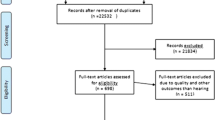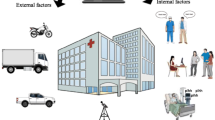Abstract
The extent of noise in five printing companies in Novi Sad, Serbia, was determined using TES-1358A Sound Analyzer with RS-232 Interface. The data on equivalent A-level (dBA), as well as, maximum and minimum sound pressure levels were collected. It was found that folders and offset printing units are the predominant noise sources, with the average L eq levels of 87.66 and 82.7 dBA, respectively. Forty percent of the machines produced noise levels above the limiting threshold level of 85 dBA, allowed by law. The noise in all printing companies was dominated by higher frequency noise, and the maximum level mostly appeared at 4,000 Hz. For offset printing machines and folders, the means of L eq levels exceeded the permissible levels given by NR-80 curve at higher frequencies. There are no published studies of occupational noise and hearing impairment of workers exposed to hazardous noise in printing industry in Serbia. More extensive studies are needed to determine the exact impact of noise on the workers. Technical and organizational measures in order to control noise and prevent noise exposure, and general hearing conservation program to protect workers, should be introduced in printing industry.
Similar content being viewed by others
References
Ahmed, H. O., Dennis, J. H., Badran, O., Ismail, M., Ballal, S. G., Ashoor, A., et al. (2001). Occupational noise exposure and hearing loss of workers in two plants in eastern Saudi Arabia. Annals of Occupational Hygiene, 45(5), 371–380.
Alberti, P. W. (1998). Noise, the most ubiquitous pollutant. Editorial. Noise & Health, 1(1), 3–5.
Arezes, P., & Miguel, A. S. (2002). Occupational risk exposure in Portugal. Official publication of the forum Acousticum, Sevilla: 3rd European congress on acoustics. Retrieved from: http://www.sea-acustica.es/Sevilla02/noi02015.pdf.
ASHA (American Speech-Language-Hearing Association) (1997). Noise. Retrieved from: http://www.asha.org/hearing/disorders/noise.cfm.
B & K (1982). Noise control: Principles and practice. Denmark: Bruel and Kjaer.
Berger, E. (1980). EARLog #5—Hearing protector performance: How they work—And—What goes wrong in the real world. Sound and Vibration, 14(10), 14–17.
Berger, E., Royster, L., Royster, J., Driscoll, D., & Layne, M. (2000). The Noise Manual (5th ed.). USA: AIHA Press, American Industrial Hygiene Association.
Boateng, C. A., & Amedofu, G. K. (2004). Industrial noise pollution and its effects on the hearing capabilities of workers: A study from saw mills, printing presses and corn mills. African Journal of Health Sciences, 11(1–2), 55–60.
Chang, T. J., Wang, V. S., Hwang, B. F., Yen, H. Y., Lai, J. S., Liu, C. S., et al. (2009). Effects of co-exposure to noise and mixture of organic solvents on blood pressure. Journal of Occupational Health, 51(4), 332–339.
CISCA (Ceilings and Interior Systems Contractors Association) (1984). Acoustical ceilings—Use and practice.
CTC (Certain Teed Corporation) (2003). Noise control in buildings—Guidelines for acoustical problem-solving. Retrieved from: www.certainteed.com/resources/30-25-047.pdf.
Davies, H. W., Teschke, K., Kennedy, S. M., Hodgson, M. R., Hertzman, C., et al. (2005). Occupational exposure to noise and mortality from acute myocardial infarction. Epidemiology, 16(1), 25–32.
Dobbie, R. A. (2002). Noise. In: P. H. Wald, & G. Stave (Eds.), Physical and biological hazards of the workplace (2nd ed., pp. 279–290). New York: Wiley.
EASHW (European Agency for Safety and Health at Work) (2000). Monitoring the state of occupational safety and health in the European Union—Pilot study. Luxembourg.
Gerges, N. Y. S., Sehrndt, G. A., & Parthey, W. (2001). Noise sources. In: B. Goelzer, C. H. Hansen, & G. A. Sehrndt (Eds.), Occupational exposure to noise: Evaluation, prevention and control. Publication Series from the Federal Institute for Occupational Safety and Health. World Health Organization 2001. Available from: http://www.who.int/occupational_health/publications/noise.pdf.
Gidikova, P., Prakova, G., Ruev, P., & Sandeva, G. (2007). Hearing impairment among workers occupationally exposed to excessive levels of noise. Central European Journal of Medicine, 2(3), 313–318.
Henderson, D., Subramaniam, M., & Boettcher, F. A. (1993). Individual susceptibility to noise-induced hearing loss: An old topic revisited. Ear & Hearing, 14(3), 152–168.
I-INCE International Institute of Noise Control Engineering (Ed.) (1997). Final report, technical assessment of upper limits on noise in the workplace (pp. 203–216). I-INCE Publication 97–1. Noise/News International. Retrieved from: http://www.i-ince.org/data/iince971.pdf.
Kim, J., Park, H., Ha, E., Jung, T., Paik, N., & Yang, S. (2005). Combined effects of noise and mixed solvents exposure on the hearing function among workers in the aviation industry. Industrial Health, 43, 567–573.
Lomen, I., Cveticanin, L., Hodolic, J., & Stevic, M. (2002). Software tool for determination of noise level in industrial plants. Acta Mechanica Slovaka, 6, 165–168.
McMahon, K. J., & McManus, P. E. (1988). Occupational noise exposure in the printing industry. American Industrial Hygiene Association Journal, 49(1), 34–37.
Mokhtar, M., Kamaruddin, S., Khan, Z. A., & Mallick, Z. (2007). A study on the effects of noise on industrial workers in Malaysia. Jurnal Teknologi, 46(A), 17–30.
Morata, T. C., Dunn, D. E., Kretschmer, L. K., Lemasters, G. K., & Keith, R. W. (1993). Effects of occupational exposure to organic solvents and noise on hearing. Scandinavian Journal of Work, Environment & Health, 19(4), 245–254.
Morata, T. C., Fiorini, A. C., Fischer, F. M., Colacioppo, S., Wallingford, K. M., Krieg, E. F., et al. (1997). Toluene-induced hearing loss among rotogravure printing workers. Scandinavian Journal of Work, Environment & Health, 23(4), 289–298.
Nandi, S. S., & Dhatrak, S. V. (2008). Occupational noise-induced hearing loss in India. Indian Journal of Occupational & Environmental Medicine, 12(2), 53–56.
Nelson, D. I., Robert, Y., Nelson, R. Y., Concha-Barrientos, M. D., & Fingerhut, M. (2005). The global burden of occupational noise-induced hearing loss. American Journal of Industrial Medicine, 48(6), 446–458.
Niland, J. (1994). Occupational hearing loss, noise, and hearing conservation. In: C. Zenz, O. Dickerson, & E. Horvarth (Eds.), Occupational medicine (3rd ed., pp. 258–296). St Louis Missouri: Mosby Publication.
NIOSH (National Institute for Occupational Safety and Health) (1998). Criteria for a recommended standard: Occupational noise exposure. Revised Criteria 1998. U.S. Department of Health and Human Services, Center for Disease Control and Prevention, Cincinnati, Ohio, USA. Retrieved from: http://www.cdc.gov/niosh/98-126.html.
NIOSH (National Institute for Occupational Safety and Health) (2001). Work related hearing loss. DHHS Publication No. 2001-103, USA.
Norton, M. P. (1994). Fundamentals of noise and vibrations analysis for engineers. Cambridge: Cambridge University Press.
Noweir, M. H., & Jamil, A. T. M. (2003). Noise pollution in textile, printing and publishing industries in Saudi Arabia. Environmental Monitoring and Assessment, 83(1), 103–111.
Okah-Avae, B. E. (1996). The science of industrial machinery and systems maintenance. Lagos: Spectrum Books Ltd.
Olayinka, O. S., & Abdullahi, S. A. (2009). An overview of industrial employees’ exposure to noise in sundry processing and manufacturing industries in Ilorin Metropolis, Nigeria. Industrial Health, 47(2), 123–133.
Prasanna Kumar, G. V., Dewangan, K. N., Sarkar, A., Kumari, A., & Kar, B. (2008). Noise exposure in oil mills. Industrial Journal of Occupational Medicine, 12(1), 23–28.
Rabinowitz, P., & Rees, T (2005). Occupational hearing loss. In: L. Rosenstock, M. Cullen, C. Brodkin, & C. Redlich (Eds.), Textbook of clinical occupational and environmental medicine (2nd ed., pp. 426–362). Philadelphia: Elsevier Saunders.
RANLWE (Regulation of allowed noise level in working environment) (1992). “Official Gazette of the SFRJ”, No 21/92 310–316.
Reinhold, K., & Tint, P. (2009). Hazard profile in manufacturing determination of risk levels towards enhancing the workplace safety. Journal of Environmental Engineering and Landscape Management, 17(2), 69–80.
Rick, N. (2004). Noise exposure standards around the world [monograph on the internet]. Washington: Department of Environmental and Occupational Health Sciences, University of Washington. Available from: http://staff.Washington.edu/meitzel/standards.htm.
Sataloff, R., & Sataloff, J. (1987). Occupational hearing loss. New York: Marcel Dekker, Inc.
Sensogut, C. (2007). Occupational noise in mines and its control—A case study. Polish Journal of Environmental Studies, 16(6), 939–942.
Sliwinska-Kowalska, M., Zamyslowska-Szmytke, W., Szymczak, W., Kotylo, P., Fiszer, M., Dudarewicz, A., et al. (2001). Hearing loss among workers exposed to moderate concentrations of solvents. Scandinavian Journal of Work, Environment & Health, 27(5), 335–342.
Smith, A. P. (1998). The World Health Organization and the prevention of deafness and hearing impairment caused by noise. Nose & Health, 1(1), 6–12.
Smith, A. P., & Broadbent, D. E. (1991). Non-auditory effects of noise at work: A review of the literature. HSE Contract Research Report No 30. London: HMSO.
Stansfeld, S. A., & Matheson, M. P. (2003). Noise pollution: Non-auditory effects on health. British Medical Bulletin, 68(1), 243–257.
Tocci, G. C. (1998). Ratings and descriptions for the building acoustical environment. In: M. J. Crocker (Ed.), Handbook of Acoustics (pp. 985–1004). New York: Wiley
Tomei, F., Fantini, S., Tomao, E., Baccolo, T. P., & Rosati, M. V. (2000). Hypertension and chronic exposure to noise. Archives of Environmental Health, 55(5), 319–325.
USDOL OSHA (U.S. Department of Labor, Occupational Safety and Health Administration) (2002). Noise and hearing conservation. Available at http://www.osha-slc.gov/SLTC/noisehearingconservation/index.htm.
Virkkunen, H., Kauppinen, T., & Tenkanen, I. (2005). Long-term effect of occupational noise on the risk of coronary heart disease. Scandinavian Journal of Work, Environment & Health, 31(4), 291–299.
Woodside, G., & Kocurek, D. (1997). Environmental, safety and health engineering. New York: Wiley
Author information
Authors and Affiliations
Corresponding author
Rights and permissions
About this article
Cite this article
Mihailovic, A., Grujic, S.D., Kiurski, J. et al. Occupational noise in printing companies. Environ Monit Assess 181, 111–122 (2011). https://doi.org/10.1007/s10661-010-1817-5
Received:
Accepted:
Published:
Issue Date:
DOI: https://doi.org/10.1007/s10661-010-1817-5




